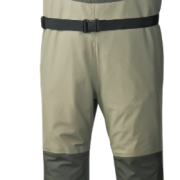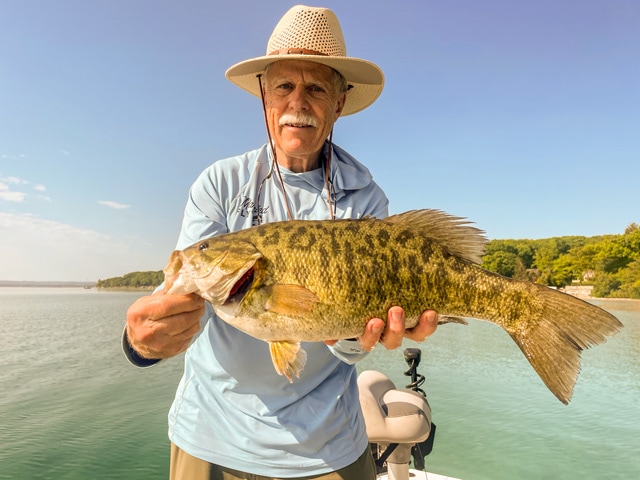Radian Review
Anyone who knows me knows that I am not a gear head. I have enjoyed being a member of Scott’s pro staff for more than a decade but will always give you an honest opinion about any given model of Scott rod if you ask. They have made many models of fly rod, and I have owned a lot of them. Many of them–but not all–have been rods that I like. Furthermore, as a guide, I have had the ability to cast a lot of different rods by other manufacturers. This is due to the fact that clients are always bringing their own rods into the boat. In this day and age, it is more difficult to find a truly bad rod. It is even more difficult to find a truly great rod that sets itself apart from all the other choices. To me, a rod has a couple of hoops to jump through to be a truly great rod. The two questions I ask myself are:
1) Is the rod versatile or is it limited in function?–This question is something that each person needs to ask when they purchase a rod. Some rods are great for dry flies, some are great for streamers, etc. Very few can do it all.
2) The second questions that I ask about a rod is something that is more apparent to a fishing guide. That question is “Is this rod durable?”. If you use a rod or reel a reasonable amount during the course of the year, and pack it and dry it after each use, you are not likely to test the limits of durability of your stick. As a guide, rods see constant use and exposure to the elements. It is blatantly obvious over time which rods are consumer grade and which are really meant to last.
There is a rod that has hit the market over last couple of years, the Scott Radian. I am happy to write this brief review that confirms that the Radian is indeed a great rod. It is more than adequate at most tasks, in fact, it is downright awesome at many of them. Furthermore, it is an extremely durable rod. Because of its versatility and its durability,I strongly recommend this rod to anyone looking for a new fly rod for fishing in Midwest waters.
I can’t recommend ever putting your fingers this close to a musky!
Here is a breakdown of the Radians that I have used extensively and a little breakdown on the performance of the rods.
Radian 908/4: This is a great heavy duty freshwater rod. It pairs with 200-300 grain sink tips, and can cast large flies better than many 9 weight rods. It is a good steelhead rod but is also a really nice smallmouth rod. When over lined, it becomes a popper fishing machine. Recently, I took this rod musky fishing alongside of 9 and 10 weight rods. I found that I put the heavier rods away and just fished this one. It was capable of casting the large flies and putting the wood to large toothy ones. I dream of the day that Scott builds the Radian in a 9 weight, but for now this is a great alternative.
Radian 907/4: This is a great streamer/smallmouth rod. As a seven weight, it is more of a niche rod for freshwater use. It is at its best with a floating line for smallmouth fishing or a 200 grain sink tip for below surface work. A good smallmouth rod needs to be able to cast a tight loop, so that flies don’t catch overhanging trees while fishing from the boat. This rod fits the bill.
Radian 906/4: Hey, I am not in the retail business, and wouldn’t typically say this. However, the 906 Radian is one of the finest all purpose freshwater rods for a Michigan angler. I own a few of these; they are my bread and butter guide rod. They are also the rod that can do just about anything you could ask while fishing for trout and smallmouth bass. This rod can cast a dry fly delicately. It has a very satisfying feel when it loads and is equally at home with a sink tip and short leader. It also roll casts nymphs and weight with ease. I don’t think it would have a problem with light duty steelhead fishing for that matter.
When I go out and fish on my own, the 906 is the rod that I always grab. The Little Muskegon River runs behind my house; it is a fair trout stream and a good place to catch smallmouth. Often times I will work my way upstream casting dry flies for trout in the riffles, only to turn around and fish heavy crayfish patterns on the way down for smallmouth. This rod handles both of these tasks easily and enjoyably. It is available with or without a fighting butt, which is a nice option to have. I always use the model with the butt attached, but you may prefer the other option.
Radian Spey 1308/4: I received this rod a few weeks ago. Aesthetically, it is a cool looking rod with orange wraps and an unsnapped blank. When I first put it together, I was a little bit concerned because it is a pretty stiff blank. I have had several shooting head rods with apparently similar action, and really didn’t like them. All this skepticism was put to rest upon the first cast of the rod. It has a great, muscular feel and casted an intermediate skagit line and a scandi head with equal ease.
OK, so these rods are great fishing rods, and they have a great deal of versatility. But how well do they hold up? I can’t guarantee this, but I am pretty sure that they know my name at the Repair Department of Scott Fly Rods. There have been years that I have sent back 15 or more broken rods in a single year. Guiding in the Midwest is inherently hard on equipment. This is especially true when you make your living casting flies with lead eyes through much of the year. Since receiving several of the Radians, not a single one has broken in over a year of heavy use (this is the main reason for this favorable review). They are heavily reinforced as is apparent on the blank. This includes fishing in all sorts of heavy and extreme weather, and being pelted by weighted eyesand split shot. I watched helplessly as a Radian was crushed by the weight of a robust angler. Somehow, the rod survived.
Due to their great performance and durability, I can recommend the Scott Radian line of rods to any Midwest angler. The 6 weight is a star and if you are looking for a fantastic, premium, all around rod, this is the best option I have seen. The other models, including the spey, are equally impressive. The versatility and the durability of the Scott Radians makes them an extraordinary series of fly rod.
Yeti Rambler – Keeps ice Longer
If you have not experienced the advantages of the Yeti Rambler Series yet, stop by your local fly shop and pick one up. From early morning coffee runs, to cold drinks on summer days, to dropping a cube in your favorite adult brown water, the Yeti Rambler series has changed the way liquids are enjoyed.
Erik Rambo shot a short time lapse of the newest Yeti Product the Low Ball , with 4 oz of his favorite Rum poured into the Low Ball. He added one ice cube that was approximately 2″ square into the Low Ball. The initial reading on the digital thermometer was 74 degrees, after the ice cube was added, the temperature dropped to 33 degrees after 3 min. At the end of the short time lapse video, you can see the temperature on the thermometer says 34 degrees. This was after 6 hours of filming. The camera battery died, but there was still ice in the glass.
DETAILS
![]()
![]()
![]()
Fly Tying – Flymen Blog Post
Great write up by Gunnar Brammer on the Flymen Blog Post about fly tying and the 3 different ways that you can use articulation in your fly design for stripping streamers. Flymen products have exploded onto the scene the last few years. Flymen products are a staple of my fly tying room. Articulated Shanks for steelhead, Fish- Skull Articulated Fish Spines , and Fish-Skull Body Tubing
Gunnar makes reference to Russ Maddin, and one of my personal favorite streamer patterns the Circus Peanut. Check out the link to the detailed how-to-tie video we did with Russ Maddin.
In my mind, Maddin’s Circus Peanut best exemplifies my personal definition of an articulated jig fly. The rear hook and front hook are identical with the exception of the chenille-wrapped lead eyes. The fly swims, jigs, and is a fish-catching machine.
The Circus Peanut has been a staple in the Russ Maddin fly box for years. The Circus Peanut originated in Northern Michigan over a decade ago and is now fished all over the world. Many streamers by many famous fly tiers have followed this same template. Russ sits down with Jon Ray from Mangled Fly Media and shows his step-by-step process.
This video breaks down the Circus Peanut and gives you full access, into the mind of fly tier, fisherman , and river steward Russ Maddin. As he discusses his methods of tying, color matching, and setting up one of the best streamers of all time.
No matter your experience level you will learn something from this video. If your into streamer fishing no matter the species this is a must watch.
New Aquaz Bootfoot Waders
I’ll be doing a more in-depth product review of the New Rogue Aquaz Waders in the coming weeks, but happy to see them arrive in the mail this week, just in time for the cold weather steelhead season. One of the secrets to finding steelhead is being able to make the cast to them. Nobody like’s cold feet, and to not have cold feet, you need to have air circulation around your toes. Boot foot waders are the secret and are so much warmer than stocking foot waders. Aquaz has teamed up with Bogs and is creating a wader for the serious steelhead angler.
The perfect lightweight wader for the backpacking angler.
BOOTFOOT WADER VERSION OF NEW ROGUE CHEST WADER / Using premium BOGS insluated boots
Stockingfoot breathable chest wader constructed of three-layer Aqualex® Pro™ fabric. Front chest pocket with YKK® water-repellent zipper closure. Lightweight, highly breathable and waterproof fabric.
Features:
- Front chest pocket with water-repellent zipper
- 2mm AirMesh and 5mm NeoTech rubber insulated boots by BOGS
- Anatomically shaped legs with seams located on outside to eliminate seam wear
- Highest quality proprietary Japanese Breathable fabrics
- Adjustable waist belt with 1 1/2” buckle
- Adjustable elastic shoulder suspenders
- Available felt sole and rubber sole
- Sold in limited quantity
Contact Brian at the Northern Angler in Traverse City, Mi to order your pair of these premium waders.
Review: Scott Tidal Muskie/Pike Special Rod
Chasing Muskies on the fly isn’t for everyone. Even the gear guys call it the “fish of 10,000 casts” (so, how many false casts is that?). But if it’s your thing, you’ll know pretty quickly. From the first eat, I fell in love. After a couple of years at it, I felt like I was putting the pieces together and wanted my own rig. As a huge fan of Scott fly rods, when the Tidal Muskie/Pike Special was announced, I knew I had my stick and placed my order. Yeah, I know, should have cast it first. But I own a bunch of Scott rods and there’s not a loser in the bunch.
Building on the very successful Tidal series, the Muskie model has a somewhat different taper, as well as an extended fighting butt (more on this later). Scott doesn’t list a line weight rating, but Scott’s Midwest rep, Jerry Darkes, told me it was rated as a 10/11 weight.
First impressions were exactly what I’ve come to expect from Scott – tight wraps, their beautiful unsanded blank, and solid, but not flashy hardware. If you need bling, these guys aren’t your company. But let’s be real – if you need bling, you’re not fly fishing for Muskie.
Last weekend I got to get in my first real outing chasing ski’s with my new stick. This was my annual pilgrimage north with Capt. Jon Ray and my Dad. JR pulled us into this crazy pursuit a couple of years back and Dad and I both took to it right away (he boated a 40″ that first year). This year I was armed with my new stick, a fresh Scientific Anglers Mastery Wet Tip Express 350 grain sink tip line, and a STUNNING Abel Super 9/10N in Muskie graphics.
The first thing I noticed when casting is that this thing is a cannon – launching a big fly and a heavy line a long distance is no problem. Back cast, wait for the load, and WHAM! But more importantly for me was accuracy. I found I could sidearm under overhanging tree limbs, hit kill holes, and generally put the fly where I wanted it with tremendous ease. As I said to Jon – “this rod casts better than I do…”. The morning of the first day we encountered some pretty serious wind and the Tidal really helped. Just by tightening up my loops I was able to maintain the control I needed. Even backhand casts gave me the same feeling of power and accuracy.
The extended fighting butt is another huge advantage. I’ve heard experienced guides say that up to 50% of their fish came from figure-eights at the boat. But figure-eighting all day is physically exhausting. The extended fighting butt enabled me to add a two-hand grip that increased rod control and gave my casting hand a break. At a recent lecture by Muskie guru Blane Chocklett, I learned another use – casting. By locking the extended but to your forearm, you spread the load out, making it easier to throw heavy flies all day. Sure enough – it works!
On the afternoon of our first day, I got to test the fighting prowess of the Tidal Muskie. We’d just moved the boat up river to a new area. On my second cast I see the perfect eat. This big girl just engulfed my fly. A hard strip-set and it’s ON! The fight is an area where this rod shines. I had plenty of power to direct the fish, gain line, and generally control the fight. The rod flexes deep to the cork without a moan, groan, or complaint. A little deft network from JR and I’m on the board!
With my other Scott rods, particularly streamer rods, I’ve found one small issue. You have to tape the ferrules. It’s the same on my Scott Radian 907/4 which I use streamer fishing for trout and smallmouth bass. If you don’t tape the ferrules, they loosen, the rod casts like pooh, and you run a greater risk of breaking a rod. I find that if I wax the ferrules once, and then tape with every use, it’s all good. A minor drawback for an outstanding rod.
If you’re looking for a great Muskie rod at a moderate price, I highly recommend the Scott Tidal Muskie/Pike Special. A solid value on a great performing rod that’s made in the U.S.A.
-Sean-
Scientific Anglers Mastery Coastal Express – Product Review
 In Michigan we are blessed with an endless supply of fresh water lakes and streams which translates into endless fishing opportunities. This however, is both a blessing and a curse as you may encounter multiple water types and consequent challenges during a fishing trip. Finding one line that can tackle most of our fishing situations on any given day is
In Michigan we are blessed with an endless supply of fresh water lakes and streams which translates into endless fishing opportunities. This however, is both a blessing and a curse as you may encounter multiple water types and consequent challenges during a fishing trip. Finding one line that can tackle most of our fishing situations on any given day is
nearly impossible. Most of our streams and lakes are featured by steep drop offs which makes it tough to properly present a streamer in most situations. For most of the streamer fishing I do here in Michigan I need a line that I can cast easily all day long and one that can cut through the water surface tension quickly and achieve sustainable depths in swift
currents in a timely fashion. The other issue I find in our region is cold weather and cold water. Now you can make the argument that this is a good thing for our trout populations but these conditions can wreak havoc on the running lines found standard on most sink tips available today. I will admit I have been frustrated for some time now with most of the lines available today as they love to twist and tangle when you shoot them to
your target often causing your cast to fall short and in a tangled up mess while your fly is sinking to the river floor, NOT GOOD! I was recently handed an SA 250 Coastal Express and immediately I fell in love with thisline. Wow, what can’t I say! 1. Immediately I was hitting my targets 15 – 20 Ft further per cast with the same amount of effort. The slightly textured line instantly improves its castability at distance. It loads quickly and shoots accurately with great fly turnover. 2. This line is designed to get down quickly and it does! The sink tip has a thin diameter which allows it to sink quicker and to achieve greater depths. With a 28 to 30′ sink tip it sinks fast and keeps your fly at your desired depth for much longer throughout your retrieve which is an important part to our fly presentation. 3. Not only was I able to cast this line further and get my flies down quicker and deeper, this line was designed for cold weather and cold water and guess what, the tangle issues I was having with the other lines, well they were reduced to nearly nothing, notta, ninja!! This line has now found a permanent place on my spools and will remain at the top of my list until SA can improve upon the existing line or come up with a new one, but I can’t imagine how they can make it that much better.
Nice work guys, I can’t wait to see whats next!
Contact your local fly shop and pick up a Coastal Express if your in need of a new sink tip fly line.
Costa Del Mar Sunglass Lens Comparison
What is the one thing, day in and day out that is most important to me for comfort, performance, and safety? What product can’t I live without everyday that I’m on the water, driving my car, and working around the house? Thinking about it, it has to be my Costa Del Mar Sunglasses. I almost live in my Costa’s wearing sunglasses honestly 365 days a year anytime I’m outside, sometimes 16 hours per day. I can remember when I made the change 5 years ago and noticed the difference right away. The lens quality of the 580 Glass and Plastic is second to none. Check out Costa’s Lens options. How light the frames are, and the ease on my eyes to look through there glass lens, is what sold me. Having recently just purchases my second pair of glasses from Costa I tried to do a len’s comparison with pictures below.
For the past 5 years I’ve been in a pair of copper lens. Love em! Perfect lens for Michigan water ways, driving, and outdoor activities. But recently with all the June fishing I was doing, and as we I stayed out later and later, I was noticing I was not comfortable the last hour of day light. That peak hour of fishing as drakes and brown trout become most active. I kept taking my glasses off, as the copper lens made me feel uncomfortable. So now I own a pair of sunrise (yellow) lens on the same frames. The perfect lens for low light and fog. Having worn the sunrise now on a few trips, I love them too. I can honestly wear them in the dark and feel comfortable and safe as we throw big size #4 hex spinners or foam bodied mouse patterns around. I put them on the first or last hour of the day, my eyes do have to adjust from the copper to the sunrise (yellow), the transition is pretty quick. Actually did notice the other morning it took my eyes a little longer for my to adjust from sunrise to copper in the morning hours, put still pretty quick and painless. Not an eye specialist and I’m sure something is going on, but just something I noticed. Was not a big deal, but like I said just something I noticed.
Did my best with a camera behind the sunglasses to so you the difference with the same shot.
Copper Lens
Sunrise
No Lens
Protect your Costa Glasses with ARC Glass Retainers
Rising Fish Tools
 A new company made it onto my radar just recently, that has some interesting tools for fishing. Company is called Rising Fish (first a really cool logo) they focus on fishing tools, (big nippa is a personal favorite), storage, and apparel. Written right on their website is the company mission – “Improving the fishing experience is why we exist as a company. We excel at identifying annoying or frustrating aspects of fishing, and then designing products to ameliorate those issues”
A new company made it onto my radar just recently, that has some interesting tools for fishing. Company is called Rising Fish (first a really cool logo) they focus on fishing tools, (big nippa is a personal favorite), storage, and apparel. Written right on their website is the company mission – “Improving the fishing experience is why we exist as a company. We excel at identifying annoying or frustrating aspects of fishing, and then designing products to ameliorate those issues”
Rising Fish is also American made and gives 1% back to the Planet. From the Bob’s Tactical Curves to the Big Nippa, you can tell the quality and workmanship is there. Great products for your fishing needs.
If your in the market for new tools check out there Dealer locator and order up. I think you will be impressed. – Rising Fish Dealer Locator










